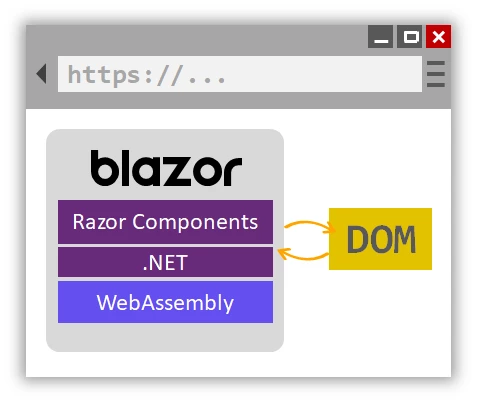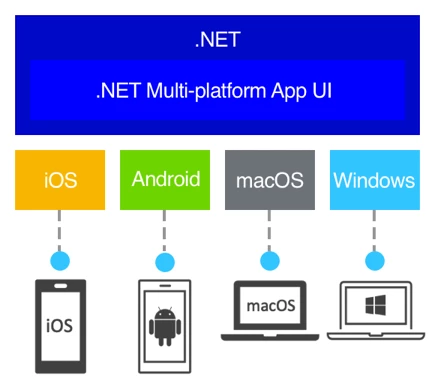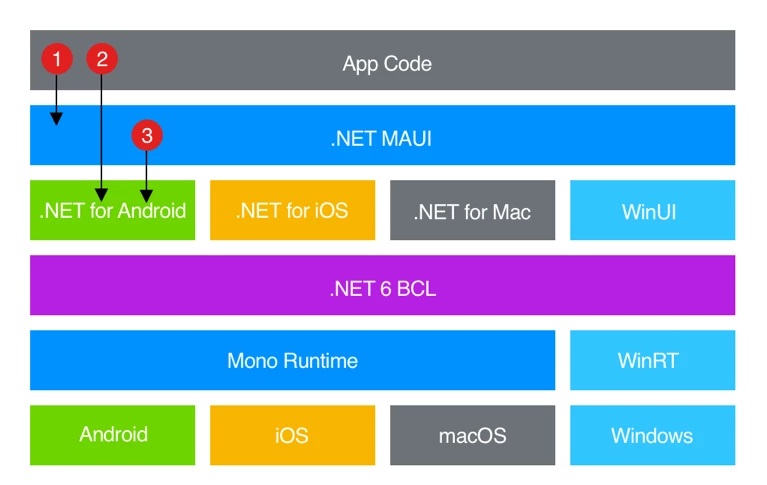Test in a live environment
Test in production without watermarks.
Works wherever you need it to.
If you're just starting with .NET development, you may have heard of two popular frameworks: Blazor and MAUI. Both of these technologies offer a way to build web and mobile applications using C# and .NET, but they differ in some key ways. In this article, we'll take a closer look at Blazor and MAUI, and help you decide which one is right for your next project.
Blazor is a web framework that allows you to build web applications using C# and .NET, instead of JavaScript. With Blazor, you can create interactive and responsive web applications using Razor syntax, a markup language that lets you combine HTML and C# code. Blazor is known for its ease of use and fast development time, as well as its ability to work seamlessly with other .NET technologies.

Blazor comes in two flavors: Blazor Server and Blazor WebAssembly. Blazor Server is a client-server architecture where the client-side code is executed on the server and communicates with the client using SignalR. Blazor WebAssembly, on the other hand, is a pure client-side architecture that compiles C# code to WebAssembly, a binary format that runs in the browser. Blazor WebAssembly offers better performance and scalability than Blazor Server but requires more client-side resources.
MAUI (Multi-platform App UI) is a new cross-platform framework that allows you to build native mobile applications for iOS, Android devices, and Windows using C# and .NET. MAUI is the successor to Xamarin, another popular framework for mobile app development. With MAUI, you can create cross-platform apps that look and feel native on each platform, and share code between them. MAUI also offers a variety of UI controls and features, making it easier to create complex native apps with less code.

MAUI is built on .NET 6 .NET 6 offers improved performance, reduced startup time, and enhanced cloud capabilities, making it ideal for building scalable and performant applications. MAUI also offers a variety of UI controls, including buttons, labels, text boxes, and more. These controls are designed to look and feel native on each platform and can be customized using styles and templates.
While Blazor and MAUI share some similarities, there are some key differences to consider when choosing which one to use for your next project.
The biggest difference between Blazor and MAUI is the platform they target. Blazor is designed for web applications, while MAUI is designed for mobile applications. If you're building a web application, you should use Blazor. If you're building a mobile application, you should use MAUI. It can be developed using Visual Studio IDE and can be tested on an android device or android emulator.
Blazor offers a variety of web UI components that allow you to create responsive and interactive web applications. MAUI also offers UI controls, but they are specifically designed for mobile applications. If you're building a mobile app, you'll need to use MAUI's UI controls. If you're building a web app, you can choose between Blazor's controls or other .NET UI frameworks like React or Angular.
Blazor and MAUI have different development workflows. With Blazor, you write C# and HTML code in the same file. With MAUI, you write C# code and XAML markup separately. This can affect how you organize your code and how you debug your application.
Blazor and MAUI have different performance characteristics. Blazor applications run in the browser and can be affected by network latency and browser performance. MAUI applications, on the other hand, are compiled to native code and run directly on the device, which typically results in better performance. However, Blazor WebAssembly has made significant strides in recent years and can offer near-native performance in some cases.
Both Blazor and MAUI allow you to share code across different platforms, but they do it in different ways. Blazor allows you to reuse .NET code between server-side and client-side applications, while MAUI allows you to share code between different mobile platforms using .NET Standard libraries. This can make it easier to maintain your codebase and reduce development time.
Blazor Hybrid is a technology that combines the power of Blazor WebAssembly with native mobile functionality. It allows developers to build hybrid applications that run on both web and mobile platforms with a single codebase. With the release of .NET MAUI, Microsoft has provided additional support for building Blazor Hybrid applications.
Blazor Hybrid apps use WebView to render the UI for the application, which allows developers to build native mobile applications with web technologies such as HTML, CSS, and JavaScript. This means that developers can leverage their existing web development skills to build mobile applications with Blazor Hybrid, while still being able to take advantage of native mobile functionality such as camera access, GPS, and push notifications.
.NET MAUI provides additional features and functionality for Blazor Hybrid apps, such as support for native navigation, device-specific UI, and platform-specific integrations. This allows developers to build high-quality and feature-rich hybrid applications with a seamless and native-like user experience.
One of the benefits of using Blazor Hybrid with .NET MAUI is the ability to share code across platforms. By using .NET MAUI, developers can write code once and use it to build applications that run on multiple platforms, including Android, iOS, and Windows. This can save time and effort in building and maintaining multi-platform applications, while still delivering a great user experience on each platform.
In summary, Blazor Hybrid with .NET MAUI is a powerful technology that allows developers to build hybrid applications with web technologies and native functionality. With support for sharing code across platforms, developers can build applications that run on multiple platforms with a single codebase, while still delivering a great user experience.

Ultimately, the choice between Blazor and MAUI depends on the specific needs of your project. If you're building a web application, Blazor is a great choice. If you're building a mobile application, MAUI is the way to go. However, it's worth noting that both technologies are highly flexible and can be used in a variety of scenarios.
One of the great things about both Blazor and MAUI is that they support a wide range of third-party libraries and components, including Iron Software's suite of .NET development tools. Here are a few examples of how Iron Software's products can be used with Blazor and MAUI:
Overall, Iron Software's suite of .NET development tools can be a great asset to developers working with Blazor and MAUI. By using these libraries and components, you can save time and effort in building high-quality applications with advanced features and functionality. Whether you're building a web application with Blazor or a mobile application with MAUI, Iron Software's products can help you achieve your goals and deliver a great user experience.
In conclusion, Blazor and .NET MAUI are two exciting technologies that are changing the landscape of software development using .NET Technology. Blazor is a great choice for building web applications, while MAUI is ideal for building cross-platform mobile applications. Both technologies offer a range of benefits, such as the ability to use C# and .NET to build client-side applications, support for modern web and mobile development patterns, and the ability to share code across platforms.
Additionally, both Blazor and MAUI support a wide range of third-party libraries and components, including Iron Software's suite of .NET development tools, which can help you build high-quality and feature-rich applications. Whether you're just getting started with .NET development or you're an experienced developer looking to stay ahead of the curve, Blazor and MAUI are worth exploring.
IronPDF, IronXL, IronBarcode and IronOCR are free to install and use for non-commercial development purposes. A free trial is available for testing in production. Look at the pricing plans for more details about prices and licensing.
Users can also benefit from Iron Suite, a collection of five professional .NET Core libraries, including IronXL, IronPDF, IronOCR, IronBarcode and others.
9 .NET API products for your office documents








